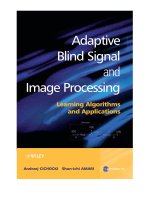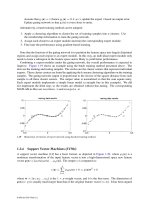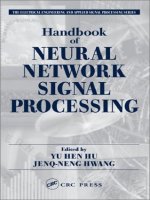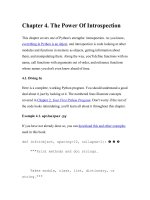Tài liệu Dive Into Python-Chapter 8. HTML Processing doc
Bạn đang xem bản rút gọn của tài liệu. Xem và tải ngay bản đầy đủ của tài liệu tại đây (212.88 KB, 66 trang )
Chapter 8. HTML Processing
8.1. Diving in
I often see questions on comp.lang.python like “How can I list all the
[headers|images|links] in my HTML document?” “How do I
parse/translate/munge the text of my HTML document but leave the tags
alone?” “How can I add/remove/quote attributes of all my HTML tags at
once?” This chapter will answer all of these questions.
Here is a complete, working Python program in two parts. The first part,
BaseHTMLProcessor.py, is a generic tool to help you process HTML files
by walking through the tags and text blocks. The second part, dialect.py, is
an example of how to use BaseHTMLProcessor.py to translate the text of an
HTML document but leave the tags alone. Read the doc strings and
comments to get an overview of what's going on. Most of it will seem like
black magic, because it's not obvious how any of these class methods ever
get called. Don't worry, all will be revealed in due time.
Example 8.1. BaseHTMLProcessor.py
If you have not already done so, you can download this and other examples
used in this book.
from sgmllib import SGMLParser
import htmlentitydefs
class BaseHTMLProcessor(SGMLParser):
def reset(self):
# extend (called by SGMLParser.__init__)
self.pieces = []
SGMLParser.reset(self)
def unknown_starttag(self, tag, attrs):
# called for each start tag
# attrs is a list of (attr, value) tuples
# e.g. for <pre class="screen">, tag="pre", attrs=[("class", "screen")]
# Ideally we would like to reconstruct original tag and attributes, but
# we may end up quoting attribute values that weren't quoted in the
source
# document, or we may change the type of quotes around the attribute
value
# (single to double quotes).
# Note that improperly embedded non-HTML code (like client-side
Javascript)
# may be parsed incorrectly by the ancestor, causing runtime script
errors.
# All non-HTML code must be enclosed in HTML comment tags (<!
code >)
# to ensure that it will pass through this parser unaltered (in
handle_comment).
strattrs = "".join([' %s="%s"' % (key, value) for key, value in attrs])
self.pieces.append("<%(tag)s%(strattrs)s>" % locals())
def unknown_endtag(self, tag):
# called for each end tag, e.g. for </pre>, tag will be "pre"
# Reconstruct the original end tag.
self.pieces.append("</%(tag)s>" % locals())
def handle_charref(self, ref):
# called for each character reference, e.g. for " ", ref will be
"160"
# Reconstruct the original character reference.
self.pieces.append("&#%(ref)s;" % locals())
def handle_entityref(self, ref):
# called for each entity reference, e.g. for "©", ref will be "copy"
# Reconstruct the original entity reference.
self.pieces.append("&%(ref)s" % locals())
# standard HTML entities are closed with a semicolon; other entities
are not
if htmlentitydefs.entitydefs.has_key(ref):
self.pieces.append(";")
def handle_data(self, text):
# called for each block of plain text, i.e. outside of any tag and
# not containing any character or entity references
# Store the original text verbatim.
self.pieces.append(text)
def handle_comment(self, text):
# called for each HTML comment, e.g. <! insert Javascript code here
>
# Reconstruct the original comment.
# It is especially important that the source document enclose client-side
# code (like Javascript) within comments so it can pass through this
# processor undisturbed; see comments in unknown_starttag for details.
self.pieces.append("<! %(text)s >" % locals())
def handle_pi(self, text):
# called for each processing instruction, e.g. <?instruction>
# Reconstruct original processing instruction.
self.pieces.append("<?%(text)s>" % locals())
def handle_decl(self, text):
# called for the DOCTYPE, if present, e.g.
# <!DOCTYPE html PUBLIC "-//W3C//DTD HTML 4.01
Transitional//EN"
# "
# Reconstruct original DOCTYPE
self.pieces.append("<!%(text)s>" % locals())
def output(self):
"""Return processed HTML as a single string"""
return "".join(self.pieces)
Example 8.2. dialect.py
import re
from BaseHTMLProcessor import BaseHTMLProcessor
class Dialectizer(BaseHTMLProcessor):
subs = ()
def reset(self):
# extend (called from __init__ in ancestor)
# Reset all data attributes
self.verbatim = 0
BaseHTMLProcessor.reset(self)
def start_pre(self, attrs):
# called for every <pre> tag in HTML source
# Increment verbatim mode count, then handle tag like normal
self.verbatim += 1
self.unknown_starttag("pre", attrs)
def end_pre(self):
# called for every </pre> tag in HTML source
# Decrement verbatim mode count
self.unknown_endtag("pre")
self.verbatim -= 1
def handle_data(self, text):
# override
# called for every block of text in HTML source
# If in verbatim mode, save text unaltered;
# otherwise process the text with a series of substitutions
self.pieces.append(self.verbatim and text or self.process(text))
def process(self, text):
# called from handle_data
# Process text block by performing series of regular expression
# substitutions (actual substitions are defined in descendant)
for fromPattern, toPattern in self.subs:
text = re.sub(fromPattern, toPattern, text)
return text
class ChefDialectizer(Dialectizer):
"""convert HTML to Swedish Chef-speak
based on the classic chef.x, copyright (c) 1992, 1993 John Hagerman
"""
subs = ((r'a([nu])', r'u\1'),
(r'A([nu])', r'U\1'),
(r'a\B', r'e'),
(r'A\B', r'E'),
(r'en\b', r'ee'),
(r'\Bew', r'oo'),
(r'\Be\b', r'e-a'),
(r'\be', r'i'),
(r'\bE', r'I'),
(r'\Bf', r'ff'),
(r'\Bir', r'ur'),
(r'(\w*?)i(\w*?)$', r'\1ee\2'),
(r'\bow', r'oo'),
(r'\bo', r'oo'),
(r'\bO', r'Oo'),
(r'the', r'zee'),
(r'The', r'Zee'),
(r'th\b', r't'),
(r'\Btion', r'shun'),
(r'\Bu', r'oo'),
(r'\BU', r'Oo'),
(r'v', r'f'),
(r'V', r'F'),
(r'w', r'w'),
(r'W', r'W'),
(r'([a-z])[.]', r'\1. Bork Bork Bork!'))
class FuddDialectizer(Dialectizer):
"""convert HTML to Elmer Fudd-speak"""
subs = ((r'[rl]', r'w'),
(r'qu', r'qw'),
(r'th\b', r'f'),
(r'th', r'd'),
(r'n[.]', r'n, uh-hah-hah-hah.'))
class OldeDialectizer(Dialectizer):
"""convert HTML to mock Middle English"""
subs = ((r'i([bcdfghjklmnpqrstvwxyz])e\b', r'y\1'),
(r'i([bcdfghjklmnpqrstvwxyz])e', r'y\1\1e'),
(r'ick\b', r'yk'),
(r'ia([bcdfghjklmnpqrstvwxyz])', r'e\1e'),
(r'e[ea]([bcdfghjklmnpqrstvwxyz])', r'e\1e'),
(r'([bcdfghjklmnpqrstvwxyz])y', r'\1ee'),
(r'([bcdfghjklmnpqrstvwxyz])er', r'\1re'),
(r'([aeiou])re\b', r'\1r'),
(r'ia([bcdfghjklmnpqrstvwxyz])', r'i\1e'),
(r'tion\b', r'cioun'),
(r'ion\b', r'ioun'),
(r'aid', r'ayde'),
(r'ai', r'ey'),
(r'ay\b', r'y'),
(r'ay', r'ey'),
(r'ant', r'aunt'),
(r'ea', r'ee'),
(r'oa', r'oo'),
(r'ue', r'e'),
(r'oe', r'o'),
(r'ou', r'ow'),
(r'ow', r'ou'),
(r'\bhe', r'hi'),
(r've\b', r'veth'),
(r'se\b', r'e'),
(r"'s\b", r'es'),
(r'ic\b', r'ick'),
(r'ics\b', r'icc'),
(r'ical\b', r'ick'),
(r'tle\b', r'til'),
(r'll\b', r'l'),
(r'ould\b', r'olde'),
(r'own\b', r'oune'),
(r'un\b', r'onne'),
(r'rry\b', r'rye'),
(r'est\b', r'este'),
(r'pt\b', r'pte'),
(r'th\b', r'the'),
(r'ch\b', r'che'),
(r'ss\b', r'sse'),
(r'([wybdp])\b', r'\1e'),
(r'([rnt])\b', r'\1\1e'),
(r'from', r'fro'),
(r'when', r'whan'))
def translate(url, dialectName="chef"):
"""fetch URL and translate using dialect
dialect in ("chef", "fudd", "olde")"""
import urllib
sock = urllib.urlopen(url)
htmlSource = sock.read()
sock.close()
parserName = "%sDialectizer" % dialectName.capitalize()
parserClass = globals()[parserName]
parser = parserClass()
parser.feed(htmlSource)
parser.close()
return parser.output()
def test(url):
"""test all dialects against URL"""
for dialect in ("chef", "fudd", "olde"):
outfile = "%s.html" % dialect
fsock = open(outfile, "wb")
fsock.write(translate(url, dialect))
fsock.close()
import webbrowser
webbrowser.open_new(outfile)
if __name__ == "__main__":
test("
Example 8.3. Output of dialect.py
Running this script will translate Section 3.2, “Introducing Lists” into mock
Swedish Chef-speak (from The Muppets), mock Elmer Fudd-speak (from
Bugs Bunny cartoons), and mock Middle English (loosely based on
Chaucer's The Canterbury Tales). If you look at the HTML source of the
output pages, you'll see that all the HTML tags and attributes are untouched,
but the text between the tags has been “translated” into the mock language.
If you look closer, you'll see that, in fact, only the titles and paragraphs were
translated; the code listings and screen examples were left untouched.
<div class="abstract">
<p>Lists awe <span class="application">Pydon</span>'s wowkhowse
datatype.
If youw onwy expewience wif wists is awways in
<span class="application">Visuaw Basic</span> ow (God fowbid) de
datastowe
in <span class="application">Powewbuiwdew</span>, bwace youwsewf
fow
<span class="application">Pydon</span> wists.</p>
</div>
8.2. Introducing sgmllib.py
HTML processing is broken into three steps: breaking down the HTML into
its constituent pieces, fiddling with the pieces, and reconstructing the pieces
into HTML again. The first step is done by sgmllib.py, a part of the standard
Python library.
The key to understanding this chapter is to realize that HTML is not just
text, it is structured text. The structure is derived from the more-or-less-
hierarchical sequence of start tags and end tags. Usually you don't work with
HTML this way; you work with it textually in a text editor, or visually in a
web browser or web authoring tool. sgmllib.py presents HTML structurally.
sgmllib.py contains one important class: SGMLParser. SGMLParser parses
HTML into useful pieces, like start tags and end tags. As soon as it succeeds
in breaking down some data into a useful piece, it calls a method on itself
based on what it found. In order to use the parser, you subclass the
SGMLParser class and override these methods. This is what I meant when I
said that it presents HTML structurally: the structure of the HTML
determines the sequence of method calls and the arguments passed to each
method.
SGMLParser parses HTML into 8 kinds of data, and calls a separate method
for each of them:
Start tag
An HTML tag that starts a block, like <html>, <head>, <body>, or <pre>,
or a standalone tag like <br> or <img>. When it finds a start tag tagname,
SGMLParser will look for a method called start_tagname or do_tagname.
For instance, when it finds a <pre> tag, it will look for a start_pre or do_pre
method. If found, SGMLParser calls this method with a list of the tag's
attributes; otherwise, it calls unknown_starttag with the tag name and list of
attributes.
End tag
An HTML tag that ends a block, like </html>, </head>, </body>, or
</pre>. When it finds an end tag, SGMLParser will look for a method called
end_tagname. If found, SGMLParser calls this method, otherwise it calls
unknown_endtag with the tag name.
Character reference
An escaped character referenced by its decimal or hexadecimal
equivalent, like  . When found, SGMLParser calls handle_charref
with the text of the decimal or hexadecimal character equivalent.
Entity reference
An HTML entity, like ©. When found, SGMLParser calls
handle_entityref with the name of the HTML entity.
Comment
An HTML comment, enclosed in <! >. When found, SGMLParser
calls handle_comment with the body of the comment.
Processing instruction
An HTML processing instruction, enclosed in <? >. When found,
SGMLParser calls handle_pi with the body of the processing instruction.
Declaration
An HTML declaration, such as a DOCTYPE, enclosed in <! >. When
found, SGMLParser calls handle_decl with the body of the declaration.
Text data
A block of text. Anything that doesn't fit into the other 7 categories. When
found, SGMLParser calls handle_data with the text.
Important
Python 2.0 had a bug where SGMLParser would not recognize declarations
at all (handle_decl would never be called), which meant that DOCTYPEs
were silently ignored. This is fixed in Python 2.1.
sgmllib.py comes with a test suite to illustrate this. You can run sgmllib.py,
passing the name of an HTML file on the command line, and it will print out
the tags and other elements as it parses them. It does this by subclassing the
SGMLParser class and defining unknown_starttag, unknown_endtag,
handle_data and other methods which simply print their arguments.
Tip
In the ActivePython IDE on Windows, you can specify command line
arguments in the “Run script” dialog. Separate multiple arguments with
spaces.
Example 8.4. Sample test of sgmllib.py
Here is a snippet from the table of contents of the HTML version of this
book. Of course your paths may vary. (If you haven't downloaded the
HTML version of the book, you can do so at
c:\python23\lib> type "c:\downloads\diveintopython\html\toc\index.html"
<!DOCTYPE html
PUBLIC "-//W3C//DTD HTML 4.01//EN"
"
<html lang="en">
<head>
<meta http-equiv="Content-Type" content="text/html; charset=ISO-
8859-1">
<title>Dive Into Python</title>
<link rel="stylesheet" href="diveintopython.css" type="text/css">
rest of file omitted for brevity
Running this through the test suite of sgmllib.py yields this output:
c:\python23\lib> python sgmllib.py
"c:\downloads\diveintopython\html\toc\index.html"
data: '\n\n'
start tag: <html lang="en" >
data: '\n '
start tag: <head>
data: '\n '
start tag: <meta http-equiv="Content-Type" content="text/html;
charset=ISO-8859-1" >
data: '\n \n '
start tag: <title>
data: 'Dive Into Python'
end tag: </title>
data: '\n '
start tag: <link rel="stylesheet" href="diveintopython.css" type="text/css" >
data: '\n '
rest of output omitted for brevity
Here's the roadmap for the rest of the chapter:
* Subclass SGMLParser to create classes that extract interesting data out
of HTML documents.
* Subclass SGMLParser to create BaseHTMLProcessor, which overrides
all 8 handler methods and uses them to reconstruct the original HTML from
the pieces.
* Subclass BaseHTMLProcessor to create Dialectizer, which adds some
methods to process specific HTML tags specially, and overrides the
handle_data method to provide a framework for processing the text blocks
between the HTML tags.
* Subclass Dialectizer to create classes that define text processing rules
used by Dialectizer.handle_data.
* Write a test suite that grabs a real web page from
and processes it.
Along the way, you'll also learn about locals, globals, and dictionary-based
string formatting.
8.3. Extracting data from HTML documents
To extract data from HTML documents, subclass the SGMLParser class and
define methods for each tag or entity you want to capture.
The first step to extracting data from an HTML document is getting some
HTML. If you have some HTML lying around on your hard drive, you can
use file functions to read it, but the real fun begins when you get HTML
from live web pages.
Example 8.5. Introducing urllib
>>> import urllib 1
>>> sock = urllib.urlopen(" 2
>>> htmlSource = sock.read() 3
>>> sock.close() 4
>>> print htmlSource 5
<!DOCTYPE html PUBLIC "-//W3C//DTD HTML 4.01 Transitional//EN"
"
<meta http-equiv='Content-Type' content='text/html; charset=ISO-8859-
1'>
<title>Dive Into Python</title>
<link rel='stylesheet' href='diveintopython.css' type='text/css'>
<link rev='made' href='mailto:'>
<meta name='keywords' content='Python, Dive Into Python, tutorial, object-
oriented, programming, documentation, book, free'>
<meta name='description' content='a free Python tutorial for experienced
programmers'>
</head>
<body bgcolor='white' text='black' link='#0000FF' vlink='#840084'
alink='#0000FF'>
<table cellpadding='0' cellspacing='0' border='0' width='100%'>
<tr><td class='header' width='1%' valign='top'>diveintopython.org</td>
<td width='99%' align='right'><hr size='1' noshade></td></tr>
<tr><td class='tagline'
colspan='2'>Python for experienced programmers</td><
/tr>
[ snip ]
1 The urllib module is part of the standard Python library. It contains
functions for getting information about and actually retrieving data from
Internet-based URLs (mainly web pages).









